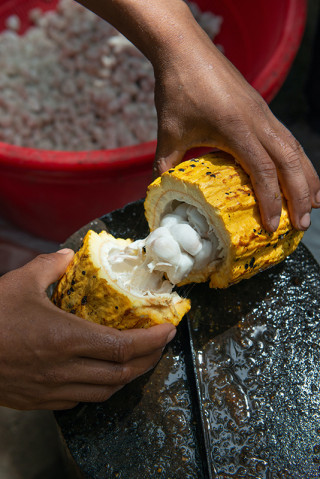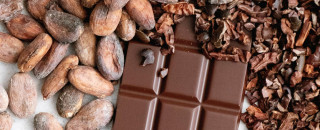A Historical Perspective on the Science of Chocolate
By Grant Olsen
Domesticated more than 3,000 years ago, cacao is a football-shaped fruit that contains a treasure that’s beloved around the world. Cut open a cacao pod and you’ll find pulp called yucca. While the yucca tastes good in and of itself, keep digging deeper and you’ll reach the seeds. These seeds are naturally bitter, but fermentation allows their structure to change on the cellular level. Aroma compounds develop and new flavors emerge.
There are still some steps left in the process, such as roasting or milling, but the result is something we all recognize: chocolate.

“The cacao pods are harvested today the same way they were thousands of years ago,” says Marcos Salaverria, director of education at Lewes Historical Society. “Chop it with a machete and crack it in half. The cacao beans are cousins to peanuts and coffee, with a flaky outer shell. Crack them open and you’ll find the nib. It’s pure 100% chocolate. When I talk to children about the harvesting process, I say that they should tell their parents that when you’re eating chocolate, you’re eating fruit!”
But regardless of its fruity origins, chocolate has a power over humans that is seldom matched by other foods. It contains hundreds of chemical compounds that bring everything from euphoria to passion to the compelling urge to gobble down another bite.
Based in Lewes, Delaware, Salaverria specializes in the role chocolate has historically played in the United States. It may come as a surprise to some of us, but chocolate was established early on in American culture. For example, between 1765 and 1773, more than 250,000 pounds of chocolate was shipped from England to the Delaware River Bay Valley.
During colonial times, chocolate was typically consumed as a warm beverage. Young children were huge fans of it and were treated to the drink on a regular basis. This heritage chocolate was thicker and heartier than anything you might enjoy today. And it was much less sugary.
The sugar content had more to do with logistics than health, as there was no sugar production in North America during the Colonial Era. Jamaica was the closest source, so sugar was transported by ship. But you couldn’t rely on receiving the sweet ingredient in a timely manner, as the journey from the southern coast of Jamaica to the American colonies could take up to a year.
With less sugar in the mix, you might be wondering what chocolate tasted like back then. One popular heritage recipe eschewed sugar altogether in favor of seven spices: nutmeg, cinnamon, vanilla, orange peel, cayenne pepper, star anise, and annatto.
Our founding fathers and mothers knew there was something in chocolate that not only tasted good but was actually good for them. The chocolate from these recipes contained a caffeine known as theobromine, which is known to boost your mood and help you feel happier.
We know today that high cacao chocolate (without lots of sugar and milk) also contains amino acid flavonoids, which are believed to help with memory recall. People in the Colonial Era observed this same phenomenon and would say, ‘Let us drink chocolate to remember, and drink wine to forget.”
So chocolate has the powerful ability to connect with people on an emotional level, leaving them in a better place than before they consumed it. During the Revolutionary War, it was given to soldiers (when available) to remind them of home. Since the Civil War, chocolate has actually been included in all military rations.
At the 2023 Chocolate & Cheese Festival, held March 11-12, NHMU visitors celebrated the rich and complex history of chocolate and cheese. The main event was a market featuring sweet-and-savory delights from some of the state’s top purveyors.
For a full sensory experience, you can register for one of the festival’s workshops. Marcos Salaverria will be hosting a workshop called “Drinking Chocolate on the Delaware River.” The presentation will focus on chocolate’s role in American history and includes the steps of the 18th century chocolate making process. Best of all, attendees will be able to sample a heritage chocolate recipe, complete with the seven spices, which is unlike anything that modern consumers have ever encountered.
